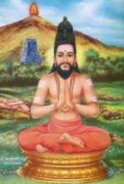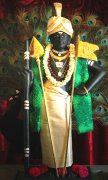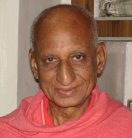

THE ESOTERIC
KANDAR ANUBHUTI
OR
THE SECRET TEACHING ON
GOD-EXPERIENCE
(A Treatise on Adwaitic Realization)
OF
SAINT ARUNAGIRINATHAR

 |  THE ESOTERIC KANDAR ANUBHUTI OR THE SECRET TEACHING ON GOD-EXPERIENCE (A Treatise on Adwaitic Realization) OF SAINT ARUNAGIRINATHAR |  |
 | by N.V. Karthikeyan |  |
| verses contents intro 1 2 3 4 5 6 7 8 9 .. 13 this verse in PDF version (2 parts) p-1 p-2 complete download of this book |
VERSE-3 வானோ புனல்பார் கனல் மாருதமோ ஞானோ தயமோ நவில்நான் மறையோ யானோ மனமோ எனையாண்ட இடம் தானோ பொருளாவது ஷண்முகனே.Vaano punal paar kanal maaruthamo, Jnaano thayamo navil naan maraiyo Yaano manamo enai aanda idam, Thaano porulaavathu shanmukhane. Is it ether, water, earth, fire, or air? Commentary This verse is an expatiation, from a Vedantic point of view, of the devotee's prayer for 'That all-ceasing and mine-losing Good' (ellaam ara ennai izhandha Nalam) of Verse-2, whereby the Sadhaka is also shown the process of rational investigation into the nature of Reality and where it is to be realised. It is something like the 'Neti-Neti' (Not this, not this) doctrine, i.e. go on rejecting the unreal as 'not this' and then what remains is the Reality. The ultimate Reality (Porul) is neither the five elements nor sensory knowledge of these elements, nor the Vedas, neither the mind nor the ego (ellaam ara); but THAT (Thaan or Self) into which the ego or individuality is absorbed (ennai izhandha). Reality ever shines in our hearts, as the Self or Atman, and can be realised when the ego is relinquished or absorbed into It. A thought-provoking verse! What is Reality? The immediate reality before us is the physical world constituted of innumerable objects. But, these are only permutation and combination in different proportions of the Pancha-Mahabhutas or five great elements viz., earth, water, fire, air, and ether. Are these elements the reality? No; neither the objects nor the elements, because these are ever-changing, while reality is unchanging and eternal. Or, is it the knowledge of these obtained through sense perception such as seeing, hearing, touching, tasting and smelling? No. Because, the senses themselves are ever changing. Is it the four Vedas, that are regarded as the repository of Knowledge, which are taught and learnt? No. The Vedas (the Upanishads) give methods or techniques of meditation on Reality, but they themselves are not the Reality. That is why it is said that even the Vedas return, unable to reach Reality (Verse-26). Is it the mind that acts on the report of the senses? No. Or is it the ego that asserts itself in everything, everywhere? No. None of these can be the reality because all these are modifications of Prakriti, which by its very nature is ever changing, being constituted of the three Gunas, viz. Sattva, Rajas and Tamas. But the investigating principle is an intelligence or consciousness, which is a reflection of the Self or Atman in the intellect or ego, and It cannot itself be unreal. When it works through the medium of the intellect, ego, mind and the senses, it gets limited to them. But by this process of enquiry when it withdraws itself from external objects to the senses, from the senses to the mind, from the mind to the intellect and the ego, it stands freed from these limiting adjuncts and then gets absorbed into its Source in the heart, in the Atman or Self. That is the 'Porul', the Reality; that is Shanmukhan. The ego fails in its attempt to know what reality is. Because Reality cannot be 'known' but is to be 'experienced'. Where the ego ceases, there reality reveals itself. In its search for reality in the outer world, in sense-knowledge, in the mental functions and even in intellectual understanding, the ego is active and intact, though in subtler and subtler degrees. But when it rejects these as inadequate and withdraws itself, it recedes into the innermost recesses of the heart, where it melts and vanishes into its source, the Atman or Self. It is like a salt-doll that tries to know the extent and depth of the ocean by looking at it standing on the shore. It cannot. But when it enters the ocean it gets melted and 'knows' the ocean by being it. The Maha-narayana Upanishad says, "In the center of the body is the sinless (egoless) lotus of the heart, which is the abode of the Supreme Being. Further within that, is the sorrowless ether (Reality). That should be meditated upon." Cessation of ego is the revelation of Reality. To know the Knower is Knowledge. It is interesting to observe that throughout the Kandar Anubhuti, the saint brings about a blend of the heart and the head, a prayerful mood and an inquiring/investigating nature -- Bhakti and Jnana, as an effective method of Sadhana. They are like the two wings of a bird which help it soar higher and higher into the empyrean of the Bliss of God-Experience. Thus, the prayer of the devotee (Bhakta) of the previous verse is immediately followed and strengthened by the investigative nature of the seeker (Jnani) in this verse. In this study, we will see the process of withdrawal from objects (family, in verse-4) and come to oneself, as the bodily self. Then one is told that he is not the body but the Self, in verse-8. Thus the process of withdrawal goes on from the physical to the subtle and causal levels of oneself until one transcends all these levels and realises the Self or Atman, God or Brahman, in verses 42, 43 and 44. |
| contents intro 1 2 3 4 5 6 7 8 9 .. 13 this verse in PDF version (2 parts) p-1 p-2 |
| ... www.kaumaram.com ... The website for Lord Murugan and His Devotees முகப்பு கௌமாரம் அட்டவணை மேலே தேடல் home Kaumaram contents top search |
Kaumaram.com is a non-commercial website. This website is a dedication of Love for Lord Murugan. Please take note that Kaumaram.com DOES NOT solicit any funding, DIRECTLY or INDIRECTLY. |